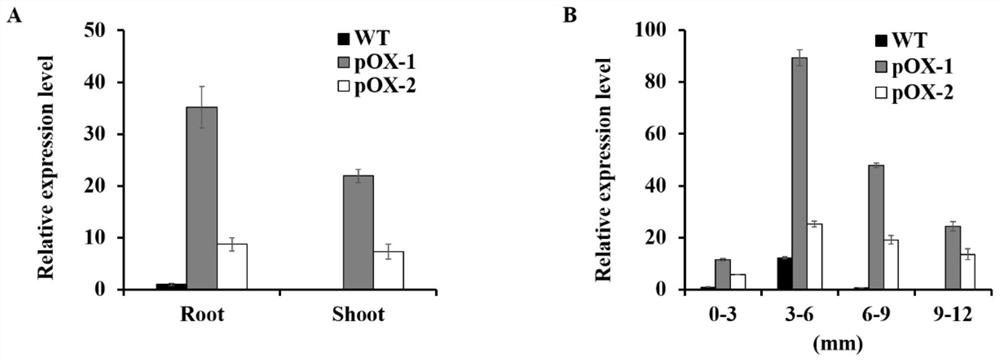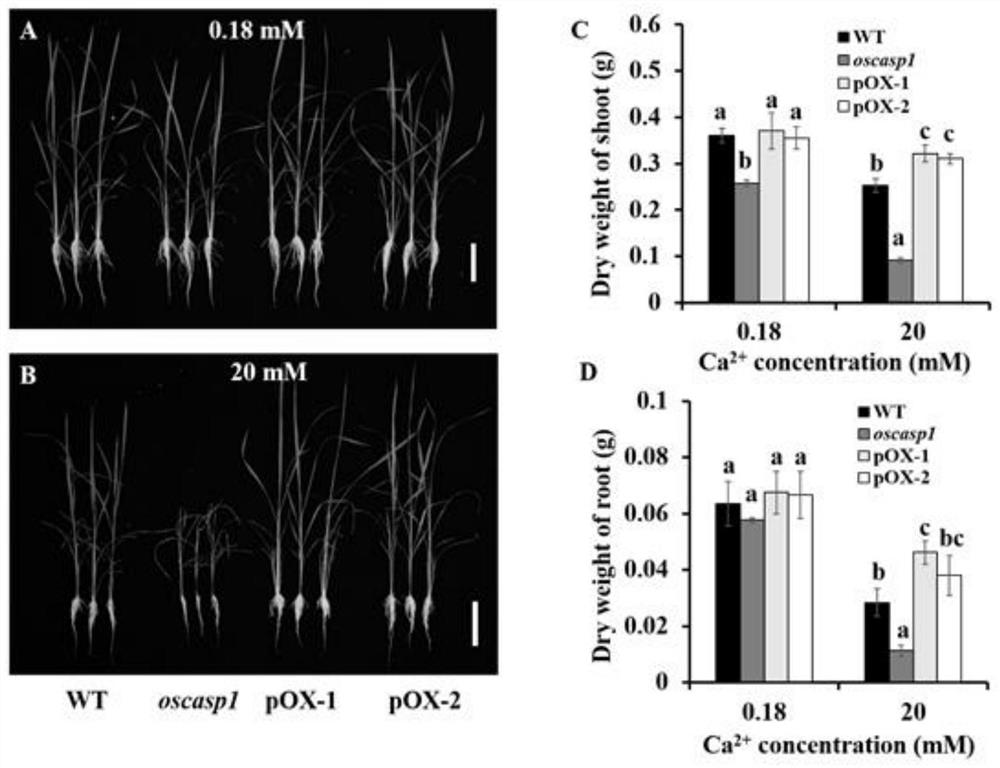Rice OsCASP1 gene and application thereof
A gene and rice technology, applied in the rice OsCASP1 gene and its application field, can solve the problems such as unfavorable plant growth, achieve the effect of improving adaptability and reducing calcium accumulation
- Summary
- Abstract
- Description
- Claims
- Application Information
AI Technical Summary
Problems solved by technology
Method used
Image
Examples
Embodiment 1
[0026] Generation of rice plants overexpressing OsCASP1 gene
[0027] The rice OsCASP1 gene was cloned into the pBR322-Pubi vector to obtain rice OsCASP1 gene overexpressed plants, the specific method is as follows:
[0028] First, the open reading frame of the rice OsCASP1 gene was amplified from the rice cDNA by PCR, with a size of 657bp. Then, use the PstI and MluI restriction sites to connect to the pBR322-Pubi vector to construct an overexpression vector, such as figure 1 As shown, finally, the constructed vector was transformed into the strain of Agrobacterium agrobacterium, and the wild-type Nipponbare rice was infected to obtain overexpressed plants, and two overexpressed plants numbered pOX-1 and pOX-2 were analyzed.
Embodiment 2
[0030] RNA extraction and gene expression analysis
[0031] In order to determine the expression level of the overexpressed plants obtained in Example 1, the roots of 7-day-old wild-type (WT) and overexpressed plants (pOX-1, pOX-2) were taken, and total RNA was extracted using Trizol reagent kit (Life technologies) , and then, use PrimeScript II 1st Strand cDNA Synthesis kit (Takara) to synthesize the first strand cDNA, and use SYBR Premix ExTaq II (Takara) for expression analysis on qTOWER 2.0 (Analytik Jena) instrument; Histone H3 is used as an internal reference, each Each experiment had three biological replicates;
[0032] The sequences of the rice OsCASP1 gene quantitative primers are TCCCGGCCTTCCTGTTCTTC (SEQ ID NO.3) and CCATGATCATGTCGCAGACG (SEQ ID NO.4);
[0033] The sequences of Histone H3 quantitative primers are GGTCAACTTGTTGATTCCCCCTCT (SEQ ID NO.5) and AACCGCAAAATCCAAAGAACG (SEQ ID NO.6);
[0034] The result is as figure 2 Shown: by figure 2 A shows that t...
Embodiment 3
[0038] Calcium Tolerance Analysis of Overexpression Plants
[0039]The wild-type (WT), oscasp1 mutant (oscasp1), and overexpression plants (pOX-1, pOX-2) with a growth period of 15 days were cultured in rice nutrient solutions containing 0.18mM and 20mM calcium, respectively, every 2 days Change the nutrient solution once, and after 14 days, take pictures and collect the roots and stems, weigh the dry weight after drying, and observe the tolerance of the overexpressed plants to calcium. The results are as follows: image 3 Shown:
[0040] Depend on image 3 A shows that under normal culture conditions (in rice nutrient solution containing 0.18mM calcium), overexpression plants (pOX-1, pOX-2) and wild type (WT), oscasp1 mutant (oscasp1) grow in the same way, however, Under high calcium conditions (in the rice nutrient solution containing 20mM calcium), the growth of overexpressed plants is obviously better than that of wild type, such as image 3 B; At the same time, the dry...
PUM
 Login to View More
Login to View More Abstract
Description
Claims
Application Information
 Login to View More
Login to View More - R&D
- Intellectual Property
- Life Sciences
- Materials
- Tech Scout
- Unparalleled Data Quality
- Higher Quality Content
- 60% Fewer Hallucinations
Browse by: Latest US Patents, China's latest patents, Technical Efficacy Thesaurus, Application Domain, Technology Topic, Popular Technical Reports.
© 2025 PatSnap. All rights reserved.Legal|Privacy policy|Modern Slavery Act Transparency Statement|Sitemap|About US| Contact US: help@patsnap.com



